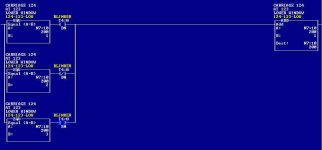TimothyMoulder
Member
Hi everyone!
These days, I'm using integer-driven sequencing to run my state logic. My current program is an update on a Micrologix 1200, with RSLogix 500 software.
First, I know RSLogix has a sequencer function, but I'm intentionally trying to develop a method that will apply to as many platforms as possible, and not everybody has a sequencer. I'd rather do the extra work and be consistent
The state logic is basic stuff. It's the following concept, applied to AB ladder logic :
if STATE (N7:0) = 2 and I:0/0 = ON, then STATE (N7:0) = 3
Meanwhile, in the output processing ladder :
If N7:0 = 2 then Latch O:0/0
If N7:0 = 3 then Unlatch O:0/0
Pretty simple concept. Here's the problem.
Even a small program has a host of states to it. Now, if I'm a maintenance man trying to trace out the outputs related to a state, I can do a "find" on the integer register, but not the VALUE!
That means I can find every reference to STATE (N7:0), but not the one or two instances where STATE (N7:0) = 2.
That means my maintenance guy is going to be searching the entire output processing ladder for every instance where N7:0 = 2, cursing me at every ladder rung.
I'm not that cruel.
I've considered every way I can think of to simplify this somehow, and make searching more intuitive, but the only thing I can think of is a logical bit for each state, that turns on the outputs. But if I do that, why not just go back to the Latch-Unlatch bit-based sequencing approach?
Now I know there are guys here who use the integer method. If any of you have tackled this issue before, what approach did you use to make the state-output relationship easier to trace?
Thanks!
TM
These days, I'm using integer-driven sequencing to run my state logic. My current program is an update on a Micrologix 1200, with RSLogix 500 software.
First, I know RSLogix has a sequencer function, but I'm intentionally trying to develop a method that will apply to as many platforms as possible, and not everybody has a sequencer. I'd rather do the extra work and be consistent
The state logic is basic stuff. It's the following concept, applied to AB ladder logic :
if STATE (N7:0) = 2 and I:0/0 = ON, then STATE (N7:0) = 3
Meanwhile, in the output processing ladder :
If N7:0 = 2 then Latch O:0/0
If N7:0 = 3 then Unlatch O:0/0
Pretty simple concept. Here's the problem.
Even a small program has a host of states to it. Now, if I'm a maintenance man trying to trace out the outputs related to a state, I can do a "find" on the integer register, but not the VALUE!
That means I can find every reference to STATE (N7:0), but not the one or two instances where STATE (N7:0) = 2.
That means my maintenance guy is going to be searching the entire output processing ladder for every instance where N7:0 = 2, cursing me at every ladder rung.
I'm not that cruel.
I've considered every way I can think of to simplify this somehow, and make searching more intuitive, but the only thing I can think of is a logical bit for each state, that turns on the outputs. But if I do that, why not just go back to the Latch-Unlatch bit-based sequencing approach?
Now I know there are guys here who use the integer method. If any of you have tackled this issue before, what approach did you use to make the state-output relationship easier to trace?
Thanks!
TM






